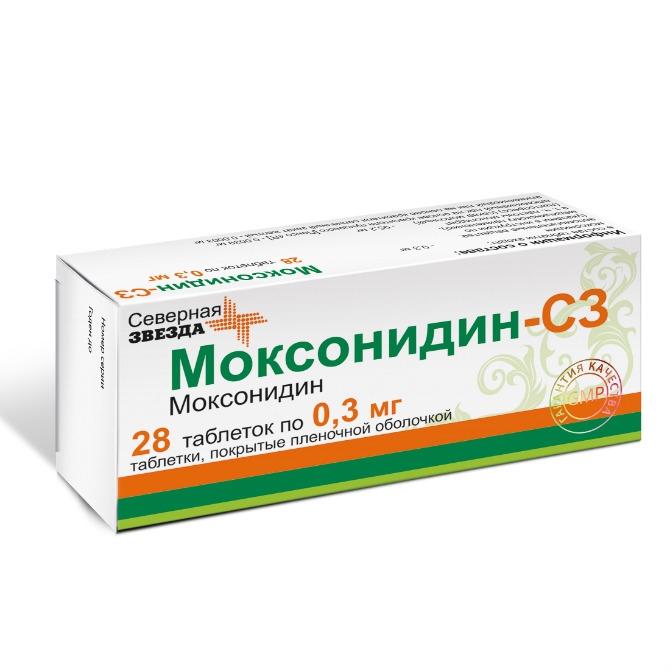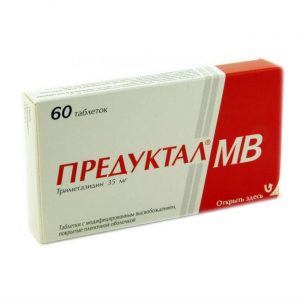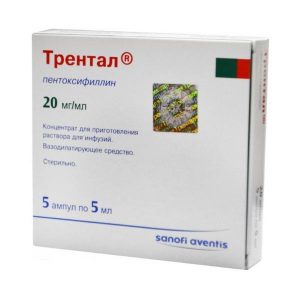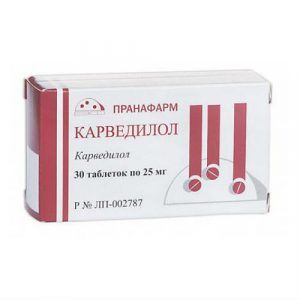Description
Release form
Tablets
Pharmacological action
An antihypertensive drug with a central mechanism of action. In the brain stem structures (the rostral layer of the lateral ventricles), moxonidine selectively stimulates the imidazoline-sensitive receptors involved in the tonic and reflex regulation of the sympathetic nervous system. Stimulation of imidazoline receptors reduces peripheral sympathetic activity and blood pressure.
Moxonidine differs from other sympatholytic antihypertensive agents in a lower affinity for β2-adrenergic receptors, which explains the lower likelihood of developing a sedative effect and dry mouth. The use of moxonidine leads to a decrease in OPSS and blood pressure.
Moxonidine improves the insulin sensitivity index (compared with placebo) by 21% in patients with obesity, insulin resistance, and moderate arterial hypertension.
Indications
rterial hypertension.
Contraindications
– severe renal failure (CC less than 30 ml / min)
– severe cardiac arrhythmias
– SSSU
– severe bradycardia (resting heart rate less than 50 beats. / min)
– AV block II and III degree
– acute and chronic heart failure (III-IV functional class according to NYHA classification)
– simultaneous use with tricyclic antidepressants
– hemodialysis
– lactation period
– over 75 years old
– age under 18 years (due to the lack of safety and efficacy data)
– hereditary lactose intolerance, lactase deficiency or malabsorption of glucose-galactose
– hypersensitivity to the active substance and other components of the drug .
Pregnancy and lactation
Clinical data on the use of moxonidine in pregnant women are not available. In animal studies, the embryotoxic effect of the drug was established. Moxonidine should be prescribed to pregnant women only after a careful assessment of the risk-benefit ratio, when the expected benefit to the mother outweighs the potential risk to the fetus.
Moxonidine is excreted in breast milk, therefore, the drug should not be prescribed during breast-feeding. If it is necessary to use the drug Moxonidine-SZ during lactation, breastfeeding should be stopped.
Composition
1 tab.
moxonidine 0.3 mg
Excipients: croscarmellose sodium (primellose) – 3 mg, lactose monohydrate (lactopress) (milk sugar) – 95.2 mg, colloidal silicon dioxide (aerosil) – 0.5 mg, sodium stearyl fumarate – 1 mg.
Shell composition: Opadry II (polyvinyl alcohol, partially hydrolyzed – 1.32 mg, titanium dioxide (E171) – 0.6003 mg, talc – 0.6 mg, macrogol (polyethylene glycol 3350) – 0.3705 mg, soy lecithin (E322) – 0.105 mg, aluminum varnish based on crimson dye [Ponso 4R] – 0.0039 mg, dye-based aluminum varnish sunny sunset yellow – 0.0003 mg).
Dosage and administration of
The drug is taken orally, regardless of food intake.
In most cases, the initial dose of Moxonidine-SZ is 0.2 mg / day. The maximum single dose is 0.4 mg. The maximum daily dose, which should be divided into 2 doses, is 0.6 mg. An individual correction of the daily dose is necessary depending on the patient’s tolerance of the therapy.
Dose adjustment for patients with hepatic insufficiency is not required.
The initial dose for patients with moderate to severe renal failure is 0.2 mg / day. If necessary and with good tolerance, the daily dose can be increased to a maximum of 0.4 mg.
Side effects of
The frequency of side effects below was determined according to the following: very often (> 1/10) often (> 1 / 100.1 / 1000,
From the central nervous system: often – headache *, dizziness (vertigo) , drowsiness infrequently – fainting *.
Mental disorders: often insomnia infrequently – nervousness
From the hearing organ and labyrinth disorders: infrequently – ringing in the ears
From the cardiovascular system: infrequently – a marked decrease in blood pressure, orthostatic hypotension * , bradycardia.
From the digestive system s: very often – dryness of the oral mucosa often – diarrhea, nausea, vomiting, dyspepsia.
From the skin and subcutaneous tissues: often – skin rash, itching.
From the musculoskeletal system: often – back pain infrequently – pain in the neck.
Allergic reactions: infrequently – angioedema.
General disorders and disorders at the injection site: often – asthenia infrequently – peripheral edema.
* – the frequency is comparable to placebo.
Drug Interactions
The combined use of moxonidine with other antihypertensive agents leads to an additive effect.
Tricyclic antidepressants can reduce the effectiveness of central antihypertensive drugs, and therefore their simultaneous use with moxonidine is not recommended.
Moxonidine may enhance the effects of tricyclic antidepressants, tranquilizers, ethanol, sedatives and hypnotics. Moxonidine is able to moderately improve impaired cognitive function in patients receiving lorazepam.
Moxonidine may enhance the sedative effect of benzodiazepine derivatives when used concurrently.
Moxonidine is secreted by tubular secretion, so its interaction with other drugs is not ruled out secreted by tubular secretion.
Beta-blockers increase bradycardia, the severity of the negative foreign and dromotropic effects.
Overdose
There have been reports of several cases of overdose without death, when doses up to 19.6 mg were used simultaneously.
Symptoms: headache, sedation, excessive decrease in blood pressure, dizziness, asthenia, bradycardia, dry oral mucosa, vomiting, fatigue, pain in the epigastric region, respiratory depression and impaired consciousness. In addition, a short-term increase in blood pressure, tachycardia and hyperglycemia are also possible, as has been shown in several studies on the use of the drug in high doses in animals.
Treatment: no specific antidote exists. In the case of an excessive decrease in blood pressure, it may be necessary to restore the BCC due to the introduction of fluid and dopamine (injection). Bradycardia can be stopped with atropine (injection). In severe cases of overdose, it is recommended to carefully monitor impaired consciousness and prevent respiratory depression. Antagonists of β-adrenergic receptors can reduce or eliminate the paradoxical hypertensive effects of an overdose of moxonidine. Moxonidine is slightly excreted during hemodialysis.
Storage Conditions
The product should be stored out of the reach of children, in a dry, dark place at a temperature not exceeding 25 ° C.
Term hodnosty
3 years
PMA pills




